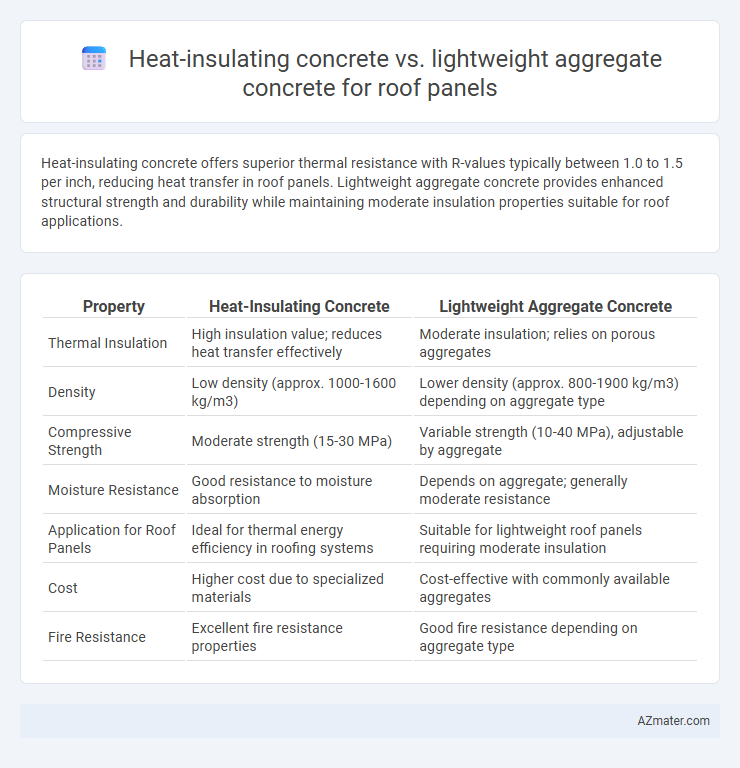Heat-insulating concrete offers superior thermal resistance with R-values typically between 1.0 to 1.5 per inch, reducing heat transfer in roof panels. Lightweight aggregate concrete provides enhanced structural strength and durability while maintaining moderate insulation properties suitable for roof applications.
Table of Comparison
| Property | Heat-Insulating Concrete | Lightweight Aggregate Concrete |
|---|---|---|
| Thermal Insulation | High insulation value; reduces heat transfer effectively | Moderate insulation; relies on porous aggregates |
| Density | Low density (approx. 1000-1600 kg/m3) | Lower density (approx. 800-1900 kg/m3) depending on aggregate type |
| Compressive Strength | Moderate strength (15-30 MPa) | Variable strength (10-40 MPa), adjustable by aggregate |
| Moisture Resistance | Good resistance to moisture absorption | Depends on aggregate; generally moderate resistance |
| Application for Roof Panels | Ideal for thermal energy efficiency in roofing systems | Suitable for lightweight roof panels requiring moderate insulation |
| Cost | Higher cost due to specialized materials | Cost-effective with commonly available aggregates |
| Fire Resistance | Excellent fire resistance properties | Good fire resistance depending on aggregate type |
Introduction to Roof Panel Concrete Types
Heat-insulating concrete roof panels incorporate materials with low thermal conductivity, such as expanded polystyrene or perlite, enhancing energy efficiency by reducing heat transfer. Lightweight aggregate concrete uses lightweight materials like expanded clay or shale, providing reduced dead load and improved fire resistance. Both types prioritize durability and thermal performance but differ in insulation properties and structural weight, influencing their application in roofing systems.
Overview of Heat-Insulating Concrete
Heat-insulating concrete enhances roof panel performance by incorporating materials with low thermal conductivity, effectively reducing heat transfer and improving energy efficiency in buildings. This type of concrete often uses expanded perlite, vermiculite, or foam glass as insulating aggregates, which contribute to superior thermal resistance compared to traditional lightweight aggregate concrete. The integration of heat-insulating concrete in roof panels not only minimizes cooling loads but also provides adequate structural strength and durability.
Understanding Lightweight Aggregate Concrete
Lightweight aggregate concrete (LWAC) offers superior thermal insulation for roof panels by incorporating specially engineered aggregates such as expanded clay, shale, or slate, which reduce density and improve heat resistance. Unlike traditional heat-insulating concrete that relies heavily on additives or foamed materials, LWAC provides enhanced structural performance with better load-bearing capacity and durability. Its balanced combination of low thermal conductivity and strength makes LWAC an optimal choice for energy-efficient, sustainable roofing systems.
Key Differences in Material Composition
Heat-insulating concrete for roof panels incorporates specialized insulating materials such as expanded perlite, vermiculite, or polystyrene beads to enhance thermal resistance, reducing heat transfer. Lightweight aggregate concrete uses lightweight natural or synthetic aggregates like expanded clay, shale, or slate, which decrease density and improve structural load capacity without prioritizing thermal insulation. The key difference lies in heat-insulating concrete's focus on thermal performance through embedded insulative additives, while lightweight aggregate concrete emphasizes reduced weight by substituting conventional aggregates with lighter ones.
Thermal Performance Comparison
Heat-insulating concrete incorporates materials such as expanded polystyrene or aerogel to significantly reduce thermal conductivity, achieving values as low as 0.12 W/m*K, which enhances energy efficiency in roof panels. Lightweight aggregate concrete, utilizing aggregates like expanded clay or shale, typically exhibits thermal conductivities around 0.20 to 0.30 W/m*K, offering moderate insulation alongside structural benefits. The superior thermal resistance of heat-insulating concrete reduces heat transfer, resulting in improved indoor temperature regulation and lower cooling loads compared to lightweight aggregate concrete in roof applications.
Structural Strength and Load-Bearing Capacity
Heat-insulating concrete offers enhanced thermal resistance while maintaining moderate structural strength suitable for lightweight roof panels, whereas lightweight aggregate concrete provides superior load-bearing capacity due to its higher compressive strength combined with reduced dead load. The cellular structure in heat-insulating concrete reduces density but may limit maximum load capacity, making it ideal for energy-efficient applications with moderate structural demands. Lightweight aggregate concrete balances structural integrity and weight reduction, supporting heavier loads without significantly compromising roof panel durability.
Energy Efficiency and Insulation Ratings
Heat-insulating concrete offers superior thermal resistance due to embedded insulating materials such as expanded polystyrene beads or aerogels, resulting in higher R-values compared to lightweight aggregate concrete. Lightweight aggregate concrete, while reducing structural weight and providing moderate insulation through porous aggregates like expanded clay or shale, typically delivers lower energy efficiency performance than specialized heat-insulating mixes. For roof panels, heat-insulating concrete maximizes energy savings by minimizing heat transfer, directly enhancing building envelope insulation ratings and reducing HVAC loads.
Installation Methods and Ease of Construction
Heat-insulating concrete for roof panels typically requires specialized formwork and precise curing to maintain its thermal properties, making installation more labor-intensive compared to lightweight aggregate concrete. Lightweight aggregate concrete offers easier handling due to its reduced weight, allowing faster placement and reduced structural support requirements during construction. Both materials demand specific techniques, but lightweight aggregate concrete generally speeds up installation and minimizes labor costs on-site.
Cost Analysis and Long-Term Value
Heat-insulating concrete for roof panels typically incurs higher initial costs due to specialized materials like aerogels or advanced foams but offers superior thermal resistance, reducing energy expenses over time. Lightweight aggregate concrete, using expanded clay or shale, provides lower upfront costs and improves structural efficiency by reducing dead load, yet may deliver moderate insulation performance requiring supplemental measures. Long-term value favors heat-insulating concrete in energy savings and sustainability, while lightweight aggregate concrete optimizes construction costs and load management with balanced durability.
Best Use Cases for Roof Panels
Heat-insulating concrete excels in roof panels where enhanced thermal performance is critical, providing superior energy efficiency through reduced heat transfer. Lightweight aggregate concrete is ideal for roof panels requiring lower structural load and improved fire resistance without compromising strength. Both materials offer unique benefits: heat-insulating concrete suits climates with extreme temperature fluctuations, while lightweight aggregate concrete is better for structures needing weight reduction and durability.

Infographic: Heat-insulating concrete vs Lightweight aggregate concrete for Roof panel
 azmater.com
azmater.com